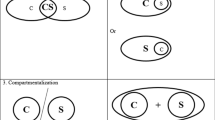Abstract
Since the mid-1980s, clinicians working in community and migrant health centers formed clinical networks to provide administrative and clinical training, regular interaction with peers, and opportunities for participation in policy formulation. The subject of this article is the most developed of the regional clinical networks, the Clinical Directors Network of Region II (CDN). CDN was created in 1985 to meet the needs of clinicians working at health centers in New York, New Jersey, Puerto Rico and the Virgin Islands. Its activities since that time suggest the potential of clinical networks to help to create professionally satisfying work experiences for health center clinicians and thus to increase clinician retention. The creation of CDN is described and its training and research activities are discussed within the context of the universe of health center clinical networks and practice-based research networks.
Similar content being viewed by others
References
Plaska, M. Vieth EA. The community health center: an enduring model for the past and future.J Ambulatory Care Manage 1995; 18 (2):3–8.
Witek, JE, Hostage, JL. Medicaid managed care: problems and promise.J Ambulatory Care Manage 1994; 17(1): 61–69.
Gamliel S, Politzer RM, Rivo ML, Mullan, F. Managed care on the march: will physicians meet the challenge?Health Affairs Summer 1995:131–142.
National Advisory Council, National Health Service Corps.Proposed Strategies for Fulfilling Primary Care Manpower Needs. Rockville, Md, 1990, pp. 24–26.
Politzer RM, Harris DL, Gaston MH, Mullan, F. Primary care physicians supply and the medically underserved, a status report and recommendations.JAMA 1991; 266: 104–109.
Leong D.Why Teaching Community Health Centers? National Association of Community Health Centers, Inc. Washington, DC, 1992: 1–8.
Calman NS, Golub M, Tobin J. The production of primary care physicians for areas of need. Paper presented at the Greater New York Hospital Fund/United Hospital Fund 1993 Health Services Research Symposium; November 10, 1993.
JSI.Retention of Physicians in Community Health Centers. Grant Application Submitted to the Agency for Health Care Policy and Research. Boston, Mass; 1991, pp. 23–24.
Dr. Stephen M. Davidson, Director of Research, JSI, July 5, 1995, personal communication.
Dr. Neal A. Demby, interview, May 16, 1991.
Dr. Murray Rosenthal, written communication, 1990; pp. 1–2. (CDN archives)
Dr. Merle Cunningham, interview, February 24, 1992.
Dr. David Stevens, interview, June 23, 1991.
Dr. Angel Braña, interview, February 25, 1991.
Dr. Jan R. Goldsmith, interview, June 24, 1991.
Dr. Margaret Teng-Lee, written communication, June 2, 1990. (CDN archives)
Dr. Gilberto Cardona, interview, June 24, 1991.
Dr. David Stevens, Speech, 1986, pp. 3–4. (CDN archives)
Dr. Juri Svarcbergs, interview, June 23, 1991.
Dr. Michael Stehney, interview, May 16, 1991.
Signature Resources,Participative and Collaborative Management, Denver, Colorado, 1989: 5–16.
Alan M. Perla, letter, December 13, 1990. (CDN archives)
Green LA, Lutz, LJ. Notions about networks: primary care practices in pursuit of improved primary care. In ML Grady (Eds)Primary Care Research: An Agenda for the 90s Rockville, Md. Agency for Health Care Policy and Research, 1990, pp. 125–132 (Publication PHS 90-3460).
Nutting PA, Alexander GP. Conducting clinical trials in practice settings: research in progress by family physicians.The Journal of Family Practice 1992; 35:689–691.
Hickner, J. Practice-based primary care research networks. In H Hibbard, PA Nutting, ML Grady (Eds)Primary Care Research: Theory and Methods. Rockville, Md. Agency for Health Care Policy and Research, 1991, pps. 13–22 (Publication 91-0011)
Nelson EC, Dirk JW, Bise BW, et al. The cooperative information project: part 1: a sentinel practice network for service and research in primary care.The Journal of Family Practice. 1981; 13:641–649.
Beasley JW, Cox NS, Livingston BT, et al. Development and operation of the Wisconsin research network.Wisconsin Medical Journal 1991; 90:531–535.
Stehney M, Li, L.Outcomes Management: Implications for Migrant and Community Health Centers, The Alliance for Primary Care, 1992.
Dr. Anita Vaughn, telephone interviews, Feb 23, March 4, 1993.
Dr. Linda Podhurst, telephone interviews, March 8, October 1, 1993.
El-Sadr W, Capps L. The challenge of minority recruitment in clinical trials for AIDS.JAMA. 1992;267:954–957.
National Cancer Institute Press Office. “NCI Launches Prescribe for Health Program”, August 9, 1991, pp. 1–4.
Dr. Jonathan N. Tobin, interview, February 19, 1993. This research builds on the work of Allen J. Dietrich, M.D., the Principal Investigator of the Cancer Control Project of CDN. This project builds on the previous research of Dr. Dietrich on the impact of physician training and the introduction of office systems structured to support cancer prevention and detection activity in ninety-eight family and internal medicine practices in Vermont and New Hampshire. See Dietrich AJ, O'Connor GT, Keller A, Carney PA, Levy D, Whaley FS. Cancer: improving early detection and prevention. A community practice randomized trial.BMJ 304; 1992; 304:687–691.
National Association of Community Health Centers, Inc.Directory of Clinical Networks. Washington, DC; 1992.
Dr. Angel Braña, the Puerto Rico Academy of Medical Directors, telephone interview, September 26, 1993.
Dr. Thomas F. Curtin, Region V Clinicians Network, telephone interview, September 22, 1993.
Dr. Maurice Click, Clinicians Network VI, telephone interview, July 15, 1993.
Mr. Richard Yoder, Western Clinicians Network, telephone interview, July 19, 1993.
Dr. Georgina Zabos, interview, June 24, 1991.
Author information
Authors and Affiliations
Additional information
This article draws on data collected as part of a historical study of the Clinical Directors Network of Region II. That research was partially supported by CDN.
An earlier version of this article was developed for the National Commission on the State and Local Public Service. Permission to include portions of the article developed for the Commission has been granted by Frank J. Thompson, Executive Director of the Commission.
The author gratefully acknowledges the information and insights provided by all of those interviewed.
Rights and permissions
About this article
Cite this article
Sardell, A. Clinical networks and clinician retention: The case of CDN. J Community Health 21, 437–451 (1996). https://doi.org/10.1007/BF01702604
Issue Date:
DOI: https://doi.org/10.1007/BF01702604



